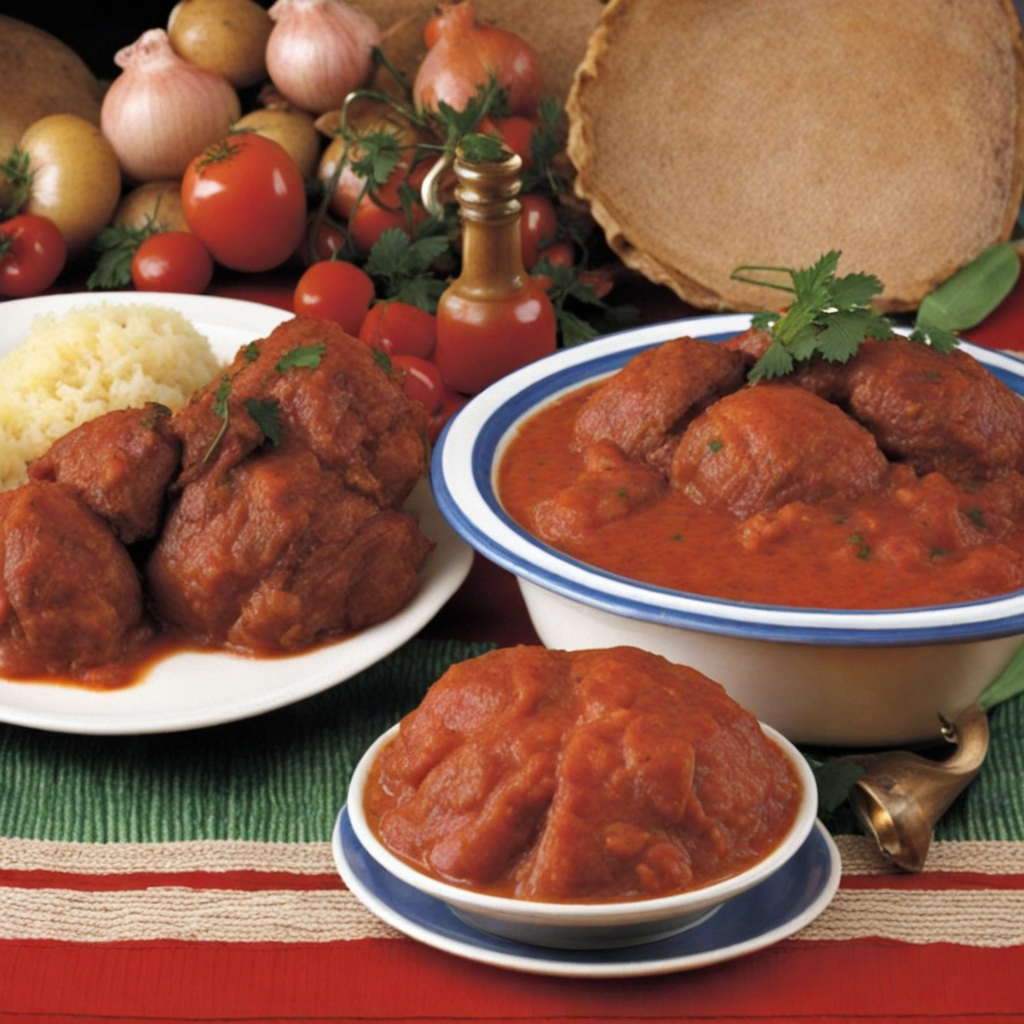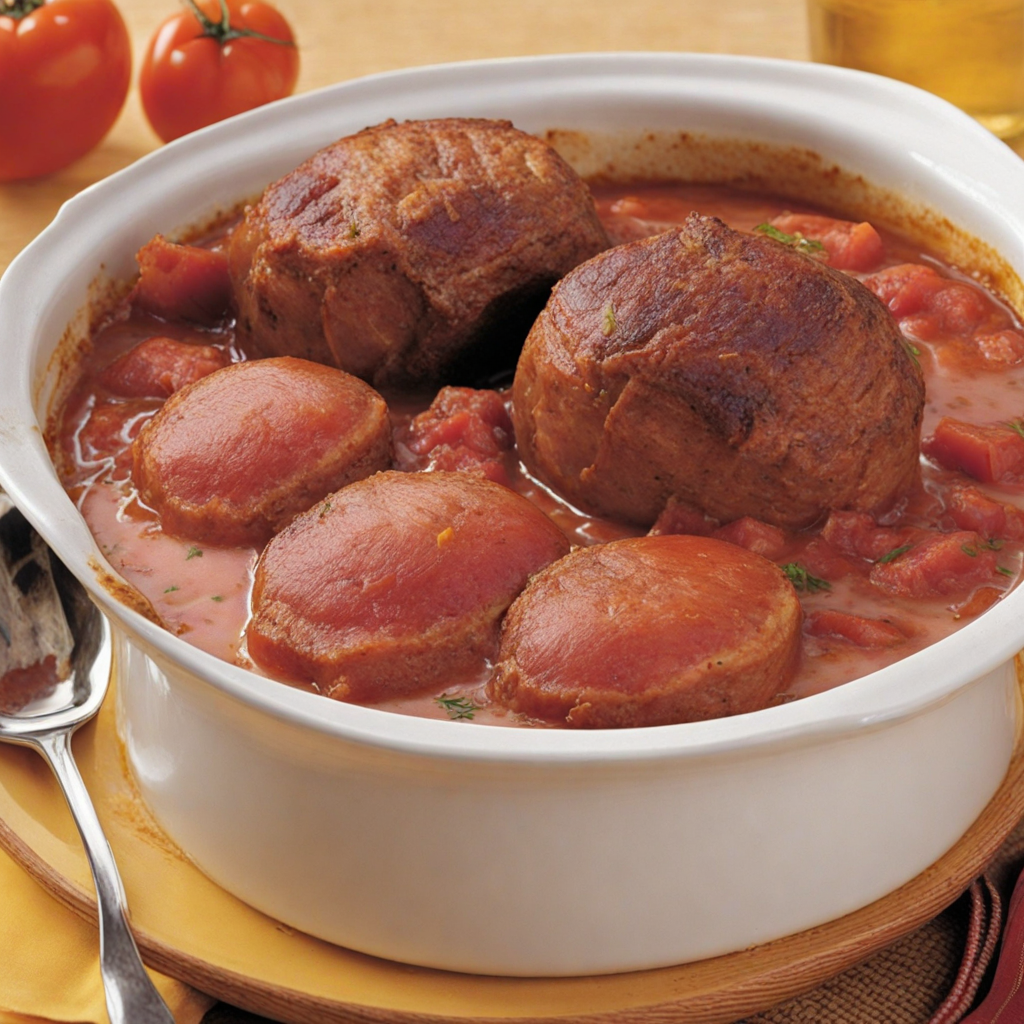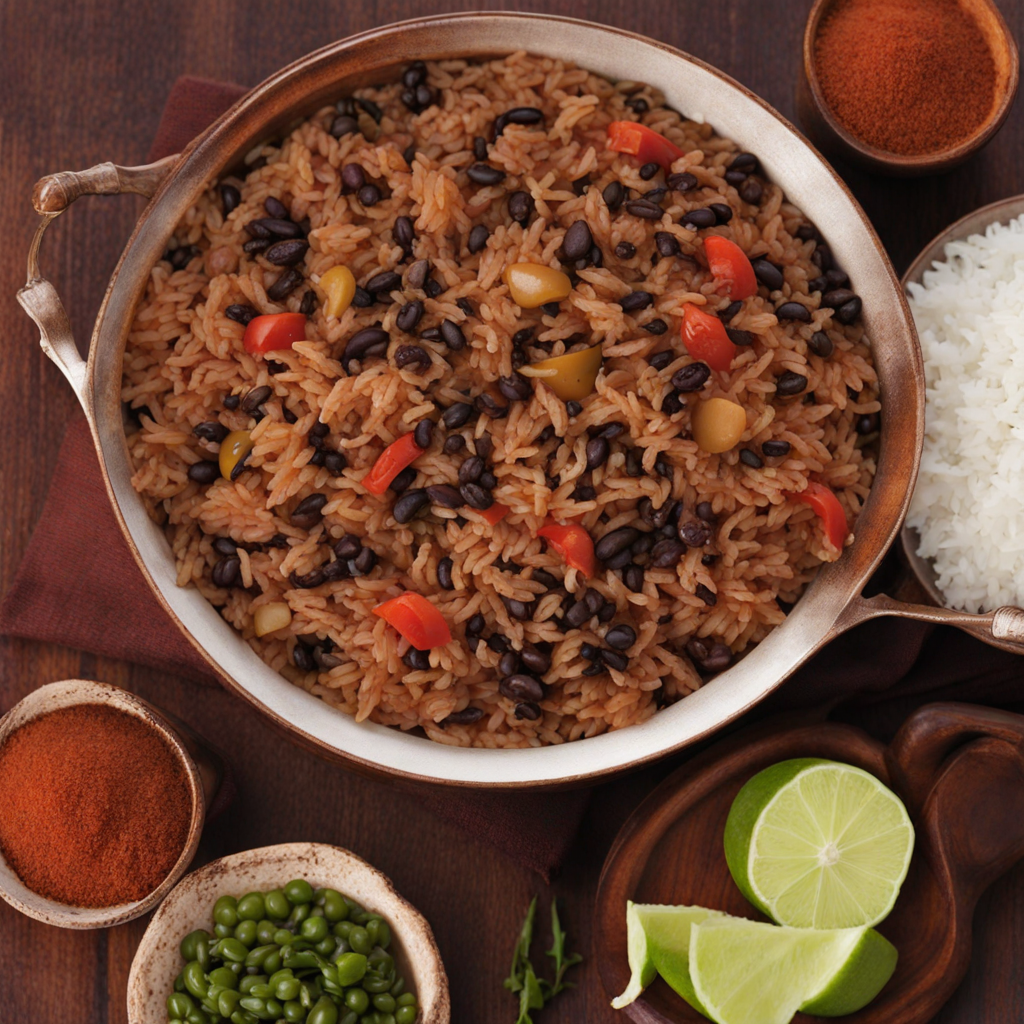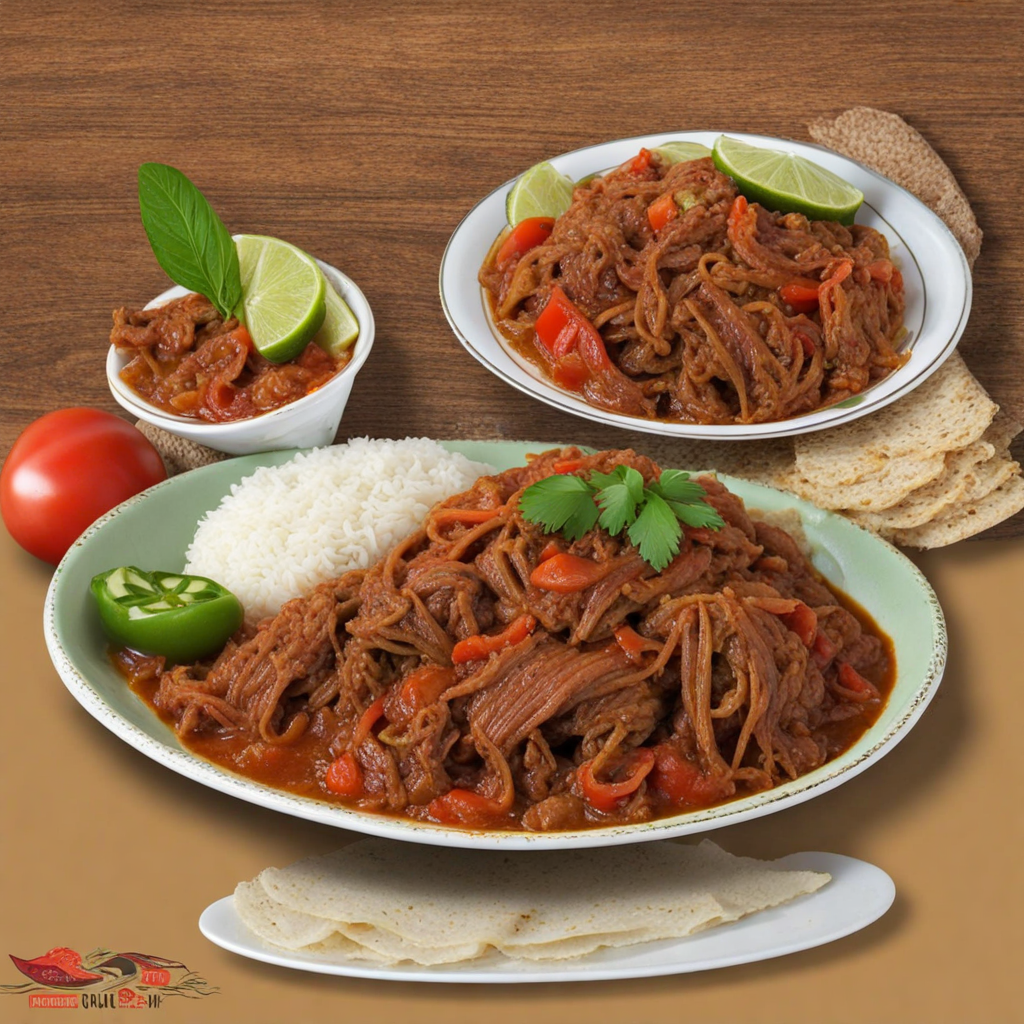Boliche
Boliche is a traditional Cuban dish that beautifully marries flavors and textures, making it a must-try for anyone interested in exploring authentic Cuban cuisine. At its core, Boliche consists of a marinated beef roast, typically a round cut, which is slow-cooked to tender perfection. The marinade often features a blend of garlic, sour orange juice, cumin, and oregano, giving the meat a vibrant and aromatic profile. The key to a great Boliche lies in the slow cooking process, which allows the beef to absorb the spices deeply while becoming incredibly tender, almost melting in your mouth. As the beef roast cooks, it is usually stuffed with a savory mixture of chorizo, olives, and even hard-boiled eggs, adding layers of flavor and a delightful surprise with every bite. This stuffing not only enhances the taste but also adds a unique texture that contrasts beautifully with the succulent meat. The dish is typically accompanied by a side of rice and black beans, which serve to balance the rich, savory flavors of the Boliche, creating a wholesome meal that embodies the heart of Cuban culinary tradition. The final presentation of Boliche is as enticing as its flavor. The roast is often sliced into thick, juicy pieces that showcase the vibrant stuffing and the rich, dark color of the well-marinated beef. A drizzle of the cooking juices over the top adds a glossy finish, making it visually appealing. Served alongside fried plantains or a fresh salad, Boliche is not just a dish; it's an experience that invites you to savor the essence of Cuban culture and its love for hearty, flavorful food.
How It Became This Dish
The History of Boliche: A Cuban Culinary Treasure Boliche is a traditional Cuban dish that represents not only the culinary heritage of the island but also its rich tapestry of cultural influences, historical events, and familial traditions. This flavorful pot roast, typically made with beef and stuffed with a savory mixture of vegetables, spices, and sometimes pork, is a celebration of Cuban culture, and its history intertwines with that of the island itself. #### Origins: A Confluence of Cultures The origins of boliche can be traced back to the Spanish colonization of Cuba in the 15th century. As Spanish settlers brought their culinary traditions to the island, they encountered indigenous Taíno ingredients and methods, creating a fusion that influenced Cuban cuisine. The Spanish introduced various cooking techniques, such as braising and roasting meats, and ingredients like olive oil, garlic, and spices, which became staples in Cuban cooking. The dish itself, boliche, is thought to have evolved from the Spanish "bollo," which refers to a stuffed meat preparation. Over time, the dish incorporated elements from Afro-Cuban cooking, which brought in flavors and ingredients from West Africa. Ingredients such as plantains, yuca, and various spices reflect this influence. Boliche, therefore, is emblematic of the diverse cultural heritage that shapes Cuban food, making it a symbol of national identity. #### Cultural Significance: More Than Just a Meal Boliche is not merely a dish; it is a significant part of Cuban family gatherings and celebrations. In Cuba, food often plays a central role in social interactions, and boliche is frequently served during special occasions such as birthdays, holidays, and family reunions. The preparation of boliche is often a communal activity, where family members gather to help in the cooking process, reinforcing bonds and creating lasting memories. The dish embodies the warmth and hospitality of Cuban culture. When boliche is served, it is accompanied by traditional side dishes such as white rice, black beans, and fried plantains, creating a hearty and satisfying meal. The act of sharing this dish serves as a reminder of the importance of family and community in Cuban society. For many, boliche is not just about nourishment; it represents love, tradition, and the resilience of the Cuban spirit. #### The Evolution of Boliche: A Culinary Journey As Cuban cuisine developed, boliche adapted to reflect the island's changing circumstances. The 20th century brought significant political and economic changes to Cuba, particularly after the Cuban Revolution in 1959. With the nationalization of industries and the imposition of trade embargos, access to certain ingredients and products became limited. This scarcity forced home cooks to innovate and modify traditional recipes, leading to variations in how boliche is prepared. In the early days of the revolution, many Cuban families faced shortages of meat and spices. As a result, boliche became a dish that could be stretched further, often incorporating less expensive cuts of meat or bulking it up with root vegetables, beans, and rice. The recipe evolved into a more economical version, ensuring that families could still enjoy this beloved dish even in difficult times. Despite these challenges, boliche remained a staple in Cuban households. The dish also found its way into the Cuban diaspora, particularly in the United States, where Cuban immigrants settled after the revolution. In cities like Miami, boliche became a symbol of cultural identity for Cuban exiles, serving as a connection to their homeland. Restaurants began featuring boliche on their menus, catering to both Cuban Americans longing for a taste of home and those curious about Cuban cuisine. #### Ingredients and Preparation: A Culinary Art The traditional preparation of boliche involves selecting a cut of beef, typically a chuck roast or eye round, which is then marinated in a mixture of garlic, sour orange juice, and spices. The marinating process is crucial, as it infuses the meat with flavor and tenderizes it. The beef is then carefully stuffed with a mixture of sautéed vegetables, often including onions, bell peppers, olives, and sometimes pork or ham, creating a delightful contrast of flavors. Once stuffed, the beef is tied or secured and seared to lock in the juices before being braised slowly with a rich sauce made from the marinade, tomatoes, and additional spices. The slow cooking process allows the flavors to meld together, resulting in a tender, juicy, and aromatic dish. The finished boliche is usually served sliced, showcasing the vibrant stuffing, and it is often accompanied by a side of rice and beans, along with fried plantains or a fresh salad. In contemporary Cuban kitchens, boliche continues to be a beloved dish, with many families passing down their unique recipes through generations. Each family may have its special twist, whether it’s the specific spices used, the stuffing ingredients, or the side dishes served alongside. These variations reflect personal histories and regional influences, showcasing the versatility and adaptability of boliche as it remains relevant in modern Cuban cuisine. #### Global Recognition: Boliche in the Culinary Landscape As Cuban cuisine gained popularity globally, boliche attracted attention beyond the Cuban diaspora. Chefs and food enthusiasts began to explore Cuban flavors, incorporating boliche into diverse culinary contexts. It appears on menus in Latin American restaurants, and some chefs experiment with fusion variations, blending boliche with other culinary traditions. The global interest in boliche highlights the broader trend of exploring authentic and diverse culinary experiences. Food lovers are increasingly seeking out dishes that tell a story, and boliche, with its rich history and cultural significance, offers a compelling narrative. As it continues to be celebrated, boliche stands as a testament to the resilience of Cuban cuisine and the enduring connection between food and culture. #### Conclusion: A Culinary Legacy Boliche is more than just a dish; it embodies the essence of Cuban culture, history, and community. From its origins steeped in a blend of Spanish and African influences to its evolution in the face of challenges, boliche represents the heart and soul of Cuba's culinary traditions. It is a dish that brings families together, evokes nostalgia, and celebrates the resilience of a people. As boliche continues to adapt and thrive in the modern culinary landscape, it remains a cherished symbol of Cuban heritage. Whether enjoyed in a family home in Havana or a Cuban restaurant in Miami, boliche invites all to partake in a delicious narrative that spans centuries, reminding us of the power of food to connect us to our roots and each other.
You may like
Discover local flavors from Cuba







